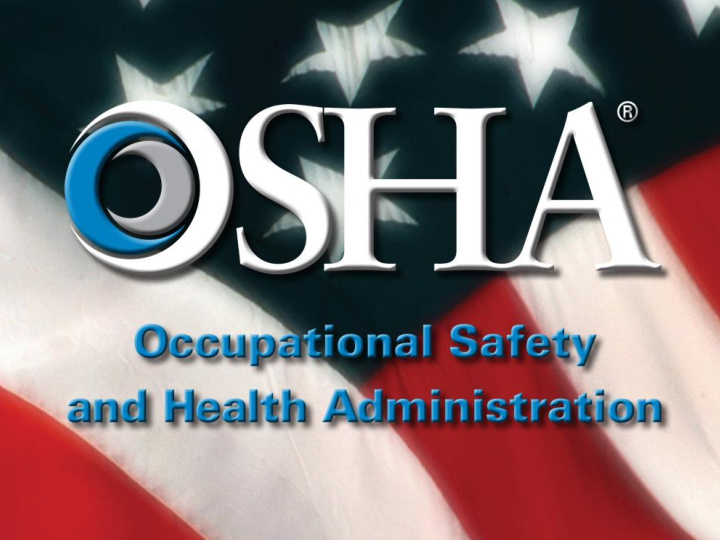



Confined Spaces in Construction 29 CFR 1926 Subpart AA Paul Bolon Office of Construction Standards NAHB June 5, 2015
Background • General Industry Standard published 1993 • United Steelworkers settlement 1994 Rule development: • Consultation with ACCSH (1990s-2002) • stakeholder meetings, • SBREFA panel (2003)
Rule development • Proposed rule published in 2007 – Comment period & public hearing • Final Rule published May 4, 2015; effective August 3, 2015
Bottom line • Final standard is very similar to the general industry standard
Basics • What is a confined space? – Big enough to enter and difficult to exit – Not for regular occupancy • Examples of spaces--sewers, pits, crawl spaces, attics, boilers, tanks, etc.
Basics….. • What is a permit-required confined space? ---A confined space with either: a hazardous atmosphere, engulfment hazard or sloping surfaces, or a serious safety or health hazard.
Basics… • What are common hazards? Low oxygen, hazardous or toxic atmospheres, flammable vapors, electric shock, hazards from the work (welding, sprays).
General requirements • Site evaluation: identify any confined spaces and permit-required confined spaces (permit spaces). • Post permit spaces. • Prevent unauthorized entry of permit spaces. • Training of all workers exposed to permit space hazards, including hazards of unauthorized rescue.
When must I have a program? • When your employees are going to enter a permit space.
Do I need a written program? Yes, if employees are going to enter permit spaces.
Is there an alternative way to enter a permit space? Yes, if you can follow all of the alternative procedures — 1926.1203(e)(1) and (2) (e)(1) (main points): • eliminate/isolate physical hazards; • air ventilation alone controls atmospheric hazards; • some documentation, then
More alternative…. you can enter a permit space under para. (e)(2) which requires (main points): • ensure entry access is safe • test the atmosphere • continuously ventilate (with enough air to allow time to exit if ventilation fails) • continuously monitor atmosphere.
Other alternative? If you can remove atmospheric hazards and other hazards are eliminated/isolated, you can re-classify the space. Note: ventilation can control but not eliminate an atmospheric hazard.
What’s in a written program for regular confined space work? 1926.1204 Permit-required confined space program (main points, for entry employers): • Plan for safe entry operations, including --identify hazards in permit spaces --control atmospheric hazards --address physical hazards --prepare for air testing and monitoring.
More program…… --control access into the space --provide equipment (air testing, ventilation, communications, PPE, lighting, etc.) --provide attendants for permit spaces --have procedures for rescue
More program….. --written permits (to identify and track authorized entrants) --maintain safe conditions for duration --plans for emergency first aid and medical support --regular or annual review of permits to identify areas to improve.
Other provisions: • Training for attendants, entry workers, entry supervisor. • Communication between employers — host, controlling, entry employers.
More provisions….. • Rescue: --non-entry rescue required unless increases risk If rely on entry rescue, must either – train and equip own employees, or – pre-arrange entry rescue service
Proper Prior Planning… • Awareness of hazards and spaces • Addressing hazards before beginning work • Contingency plans (multiple layers of protection) in case something goes wrong. • With planning and forethought, many construction employers will be able to avoid the need for a permit space program.
Who does what? • Site evaluation: – Any employer whose employees are exposed to confined space hazards must ensure that the site is evaluated by a competent person and spaces are posted. • Permit issuance: – Entry employers (employers who direct workers to perform work in a space) must develop and post permits.
What’s Different? • General Industry, plus — same require- ments as 1910.146, with some additions: • Continuous monitoring of atmospheric and engulfment hazards • Clarifies with explicit statement that employers relying on local emergency services for rescue must arrange for responders to notify in advance if they will be unavailable. • Permits may be suspended instead of cancelled, provided the space is returned to permit conditions prior to re-entry.
General industry, plus (cont’d) – Competent person evaluates spaces. – Specific information exchange requirements for multi-employer work sites.
Information Exchange
What standard to follow? • What if an employer does construction and maintenance/general industry work in the same space at the same time? – Employers with workers engaged in both types of work will be in compliance with both standards if they follow 1926 Subpart AA.
Double Fatality: August 28, 2014 • Bo Taylor entered a manhole at a construction site to apply aerosol sealant. He was overcome by fumes and fell face first into 3 feet of water at the bottom. • Trent Sorenson, the site superintendent and Bo’s uncle, entered the manhole to attempt rescue. He became unconscious and fell on top of Bo.
Double Fatality: August 28, 2014 • Tyler Sorenson left the site in order to call emergency services. He returned with a volunteer who had his own SCBA. • The volunteer attempted rescue, but a crack in the mask forced him to stop. • EMTs arrived and extracted the victims 45 minutes after Bo’s initial loss of consciousness.
Residential Incidents • Plumber performing renovation work in a crawl space was electrocuted when someone in the house turned the circuit back on – LOTO would have prevented. • Explosion in attic during spray-foam insulation installation. • Cable installer electrocuted in crawl space.
Information and Outreach • http://www.osha.gov/confinedspaces/index.html# – Fact Sheets and FAQs – Small Entity Guide forthcoming – Additional outreach documents forthcoming – Webinars and presentations • NAHB webinar on July 7, 2015
Contact Please send questions and comments to douma.jessica@dol.gov OR 202-693-2020
Recommend
More recommend